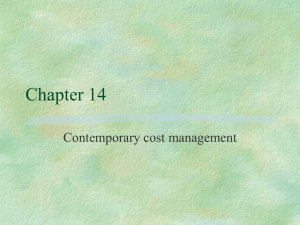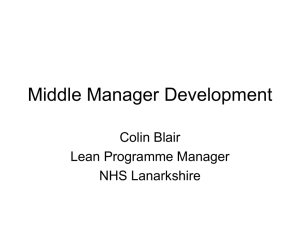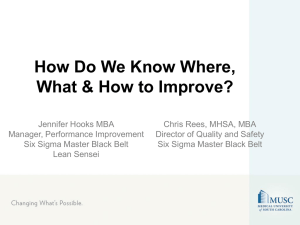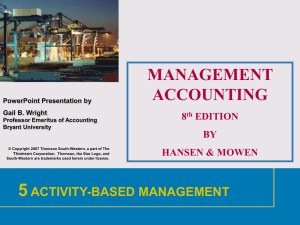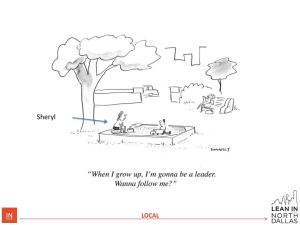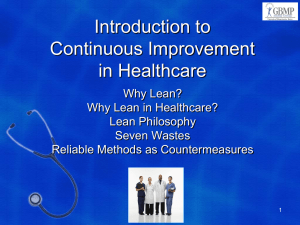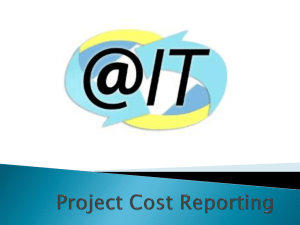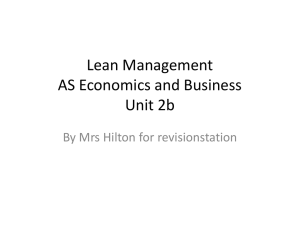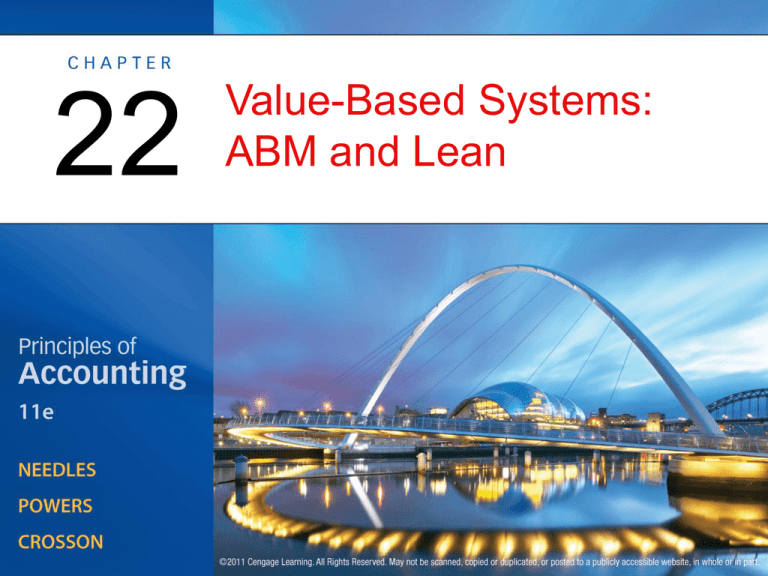
22
Value-Based Systems:
ABM and Lean
Value-Based Systems and Management
OBJECTIVE 1: Explain why managers use
value-based systems and discuss their
relationship to the supply chain and the
value chain.
Figure 1: The Supply Chain and Value
Chain in a Furniture Company
Value-Based Systems and Management
• Managers create value and satisfy
customers five ways.
– Work with suppliers and customers
– View the organization as a collection of valueadding activities
– Use resources for value-adding activities
– Reduce or eliminate non-value-adding
activities
– Know the total cost of creating value for a
customer
Value-Based Systems and Management
• Value chains and supply chains give
managers a better understanding of their
company’s internal and external operations.
– A value chain is a sequence of activities that
add value to a company’s product or service.
– A supply chain is the path that leads from the
suppliers of the materials from which a product
is made to the final customer; it includes both
suppliers and suppliers’ suppliers, and
customers and customers’ customers.
Value-Based Systems and Management
• Process value analysis helps managers
reduce costs by identifying and eliminating
non-value-adding activities.
Value-Based Systems and Management
• Compare value-adding and non-valueadding activities.
– A value-adding activity adds market value to a
product or service.
– A non-value-adding activity adds cost to a
product or service but does not increase its
market value.
Value-Based Systems and Management
• Value-based systems
– Create opportunities to improve nonfinancial
performance measures and cost information
supplied to managers
– Help managers view their organization as a
collection of activities
Value-Based Systems and Management
• Activity-based management (ABM)
– Provides financial and performance
information at key operational activity levels.
– Eliminates waste and inefficiencies.
Value-Based Systems and Management
• A lean operation eliminates waste three
ways
– Good planning and design
– Smart production scheduling and standardized
product and processing plans
– Analysis of worker and machine actions
©2011 Cengage Learning All Rights Reserved. May not be scanned, copied or duplicated, or posted to a publicly accessible website, in whole or in part.
Activity-Based Costing
OBJECTIVE 2: Define activity-based costing
and explain how a cost hierarchy and a bill
of activities are used.
Table 1: Sample Activities in Cost
Hierarchies
Activity-Based Costing
• Activity-based costing (ABC) calculates a
more accurate product cost than traditional
methods.
Activity-Based Costing
• A cost hierarchy is a framework for
classifying activities according to the level
at which their costs are incurred; in a
manufacturing organization, the cost
hierarchy typically has four levels:
–
–
–
–
Unit level
Batch level
Product level
Facility level
Activity-Based Costing
• A bill of activities is used to compute the
following:
– Costs assigned to activities
– Product unit cost
©2011 Cengage Learning All Rights Reserved. May not be scanned, copied or duplicated, or posted to a publicly accessible website, in whole or in part.
The New Operating Environment and Lean
Operations
OBJECTIVE 3: Define the elements of a lean
operation and identify the changes in
inventory management that result when a
firm adopts its just-in-time operating
philosophy.
Table 2: Direct and Indirect Costs in
Traditional and JIT Environments
The New Operating Environment and Lean
Operations
• Lean operations philosophy
– Simple is better
– Quality of product or service critical
– Work environment emphasizes continuous
improvement
The New Operating Environment and Lean
Operations
• Lean operations philosophy (cont.)
– Large inventories was resources and might
hide poor work
– Reduce or eliminate activities or functions that
do not add value
– Goods should be produced only when needed
The New Operating Environment and Lean
Operations
• Lean operations philosophy (cont.)
– Workers must be multiskilled and help
eliminate waste
– Long-term relationships with suppliers is
important
The New Operating Environment and Lean
Operations
• Just-in-time (JIT) operating environment
eliminates waste through 6 principles.
– Minimum inventory levels
– Pull-through production
– Quick setup and flexible work cells
The New Operating Environment and Lean
Operations
• Just-in-time (JIT) operating environment
eliminates waste through 6 principles.
(cont.)
– A multiskilled work force
– High levels of product quality
– Effective preventive maintenance
The New Operating Environment and Lean
Operations
• Continuous improvement of the work
environment
The New Operating Environment and Lean
Operations
• Accounting for product costs in a JIT
Operating Environment
– Classifying costs
•
•
•
•
•
Processing time
Inspection time
Moving time
Queue time
Storage time
The New Operating Environment and Lean
Operations
• Accounting for product costs in a JIT
Operating Environment (cont.)
– Assigning costs
• Managers focus on throughput time.
• Several costs that are treated as indirect costs in a
traditional environment are treated as direct costs of
a JIT work cell.
©2011 Cengage Learning All Rights Reserved. May not be scanned, copied or duplicated, or posted to a publicly accessible website, in whole or in part.
Backflush Costing
OBJECTIVE 4: Define and apply backflush
costing, and compare the cost flows in
traditional and backflush costing.
Figure 2: Comparison of Cost Flows in
Traditional and Backflush Costing
Figure 3: Cost Flows Through T Accounts
in Traditional and Backflush Costing
Backflush Costing
• A JIT operating environment simplifies cost
flows through the accounting system.
– Conversion costs
– Elimination of Materials Inventory account
Backflush Costing
• Backflush costing saves time and cuts
costs.
©2011 Cengage Learning All Rights Reserved. May not be scanned, copied or duplicated, or posted to a publicly accessible website, in whole or in part.
Comparison of ABM and Lean
OBJECTIVE 5: Compare ABM and lean
operations as value-based systems.
Table 3: Comparison of ABM and Lean
Value-Based Systems
Comparison of ABM and Lean
• Both ABM and lean seek to eliminate
waste, reduce non-value-adding activities,
and improve allocation of resources.
Comparison of ABM and Lean
• The two systems differ in their methods of
costing and cost assignment:
– ABM uses cost drivers to assign indirect costs.
– The overhead costs incurred in a JIT work cell
become direct costs of the products made in
that cell.
Comparison of ABM and Lean
• The two systems differ in their methods of
costing and cost assignment: (cont.)
– ABM uses job order or process costing to
calculate product costs.
– Lean may use backflush costing.
©2011 Cengage Learning All Rights Reserved. May not be scanned, copied or duplicated, or posted to a publicly accessible website, in whole or in part.


